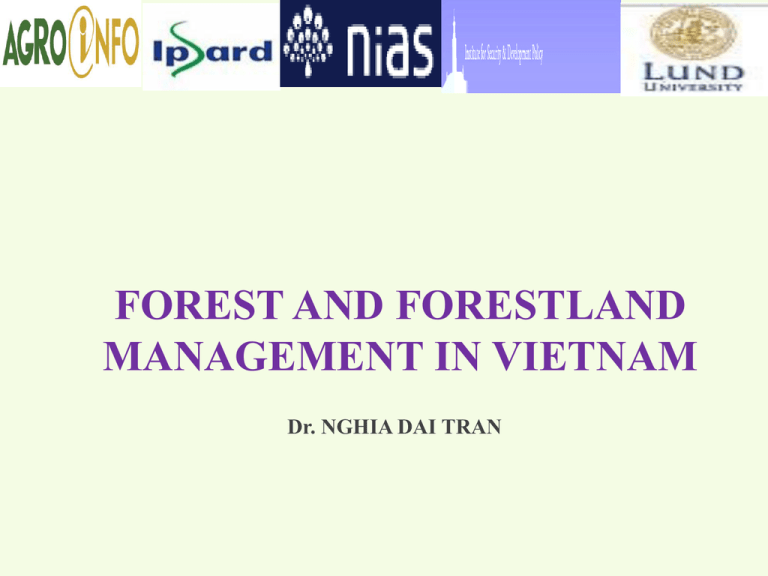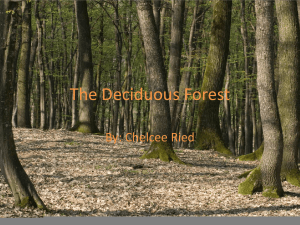forest & forestland in the economy of vietnam
advertisement

FOREST AND FORESTLAND MANAGEMENT IN VIETNAM Dr. NGHIA DAI TRAN FOREST & FORESTLAND IN THE ECONOMY OF VIETNAM • • • • 2/3 of total natural area of VN are mountainous & upland areas Forestland accounts for 57% of the total of 26.2 million ha for agriculture and forestry Homes and livelihoods for 25 million people & many of them are poor and ethnic minorities. Play an important role in protecting environment, water resources and conserving bio-diversity, especially in the context of CC Aqua land 3% Forest Land 57% Agri 40% FOREST & FORESTLAND IN THE ECONOMY OF VIETNAM (cont.) Increased pressure of economic development on forests and forestland due to constraints/reaching limits of investment on low land (keeping untouched land designated for rice). Inefficient uses of forestland Restructuring the agricultural sector in Vietnam starting from special re-arrangement for production and subsectors . Forestland use of Vietnam Indicator 1) Total of forestland a- Natural production forest b- Planted production forest c- Natural protection forest d- Natural special use forest e- Bare land and bare hills Total (a+b+c+d+e) 2) Difference Area (1000 ha) By MARD By MONRE 16240 15346 4097 2277 7452 4232 5753 1922.5 2141 3712? 12528 0 2438 0 • Not consistent statistically reported data between data from MARD and MONRE, GSO? • There are 2.0 million ha of forestland published by different government agencies? Forestland distribution by different stakeholders • • • The published data are mostly on papers and they are far different from reality owned by different stakeholders. SOEs hold majority of forestland. According to statistical data provided by provinces, SOEs and People committees ( commune. District) hold more than what indicated on papers they received Comu. 2% HH 25% PCs 16% Gov Org. 57% Changes of forestland over the last decade (thousand ha) 18000 16000 14000 Tổng tích đất lâm Totaldiện forestland nghiệp Production Đất rừng sản xuất 12000 10000 forestland Đất rừng phòng hộ Protection forestland Special use dụng forest Đất rừng đặc 8000 6000 Đất ươm cây giống lâm Forestry nurseries nghiệp 4000 2000 0 2000 2001 2002 2003 2005 2006 2007 2008 2009 2010 State owned forestry enterprises N0 (1) 1 2 Indicator (2) Total By provincial government By federal government * 2005 is the year of restructuring SOFEs. • • • • Before 2005* (3) 256 231 25 In Changes 2011 (4) 148 138 10 (+) (-) (5) -108 -93 -15 Source: MARD, 2013. Reduced by a half The area managed by SOFEs reduced by 50% Handing over to local government to manage 585.000 ha Had been done on paper/map not actually on sites handover. Change in Forestland Managed by SOFEs N0 Indicator Unit by 2011 (1) (2) (3) (5) A Total (I+II) ha 2.064.690 I Agriculture land ha 1.954.512 1 Forestland ha 1.904.700 1.1 Production forest ha 1.529.262 1.2 Protection forest ha 362.221 1.3 Special used forest ha 13.217 Source: MARD, 2013. 1- Logging and forest plantation 1. Logging and lumbers are main income source of many SOFEs. 2. Logging causes big problems in many localities. 3. People asking to review Decree QĐ 186 Not many SOFEs investing in forest plantation/reforestation Forestland uses by SOFEs No Indicator Unit in 2011 (1) (2) (3) (5) I Total land owned ha 2.064.690 1 Used by the enterprise ha 1.868.383 2 Contracted out ha 667.500 3 Jointly operate/production ha 23.102 4 leases ha 810 5 In deputes/used by others without permission+ unclear uses ha 58.604 Source MARD, 2012 FORESTRY VALUE CHAIN 4,000 3,500 3,000 2,500 2,000 1,500 1,000 500 0 1996 1998 2000 2001 2002 2003 2004 2005 2006 2007 2010 Value of export turnovers from forest and wooden products in period from 1996-2010 of Vietnam Forests and forestland managed by the Forest management Boards Hold a significant proportion of forestland; Lack of resources ( human and capital) to invest in forest plantation and protection Propose to be a kind of semi-government agency so that they can plant and operate forest production and business. Forestland managed by Commune People Committees (CPC) 1. CPCs own a significant proportion of forestland, however, the exact area held are unclear (2.6 million ?); 2. CPCs usually manage or are owners of the forestland that used to belong SOFEs but they had not been able to manage therefore they hand it over to the localities ( communes). Production forestland managed by communities Community forest management models are not clear - CFM (Community forest management) - Community based forest management - Forest managed by groups of individual forest holding households Community managed forest in Buôn Tul, Đắc Lắc (picture taken in 2010) Production forest management by private enterprises • Allocated with a small part of forestland, but they have a real need of land for forest plantation • Have to contract, affiliate with HH, SOFEs, FMBs for forest plantation; • High level of investment - financial need; • Have just been implementing some project recently. Forest plantation of Tân Mai paper company, Đắc Nông Forestland held/owned/managed by individual households 1. Most of the forest holding households do not have enough forestland for ensuring their livelihoods 2. The average forestland area allocated to an individual household is quite small <2 ha/hh: insufficient for sustaining house’s living CBA for 1 ha of acacia plantation in 10 years by a household Indicator Results Return to investment 1.21 NPV 5.27 US$ IRR 12% FACTORS EFEECTING INCOME FROM FOREST AND FORESTLAND Average income from planted forest compared with planted forest area owned by a household (million/ha/year) 0 10 20 30 40 50 60 70 80 90 100 income fromofthe plantaion (million/ha/year) forests Average income Average from planted forest household 0 1 2 3 4 plantatrion forest area owned by a household (ha) Planted forest area of household (ha) 5 DEVELOPING LIVELIHOOD AND JOB FOR FORESTRY LABOURS Average income from forest and forest land (million VND/ha/year) Land use activities Average income Average production cost Net income Planted forest Natural forest 1.15 0.02 0.64 0.02 0.51 0 Industrial crops 29.5 15.41 14.09 Annual crops 8.86 5.56 3.3 Aquaculture 18.45 12.62 5.83 11.56 3.35 8.21 Average income from forest and forest land OWNERSHIP AND FORESTLAND DISTRIBUTIONS Illegal exploitation has been popularly occurring in protection forests and special used forests under management of state’s forest management boards Forestland allocation process was carried out with a lack of community participation and mainly allocated based on the forest map, the allocation, measurement, indicating borderline on land are still limited, leading to big gap between the area an individual received on paper (drawn from the map) and the actual area owned in reality Some conflicts raised from forestland allocation issue for households Lack of support policies after allocating forest and forestland for forest owners Policy implications Wood and wood products play an importance role to farmer’s livelihood, especially the forest-dependent people Non-timber products such as bamboo shoots, medicinal herbs, … are the second most important livelihood for local people and the people living in natural forestland Policy implications Agro-forestry production is an effective method in developing livelihood for forest-dependent people Environmental service payment is one of solutions to create income for forest protection management Community forest management is considered as an approach for sustainable forest management in general and for Vietnam in particular. Policy implications Effective exploitation, combined with forest resource protection and development Strengthening current forest planting and protection Forest protection and development need to follow planning, ensuring benefit balance between forest owners and state All activities threatening forest resource must be banned Government supports livelihood activities through infrastructure development and land and forest allocation policies Policy implications Inappropriate forestland distribution among forest owners being individual and state’s companies, enterprises. Inappropriate forest and forestland use and exploitation because of limited resources (in Central Highland) Household owners using forest and forestland more effective than other owners. Lessons learnt from Bai Bang A substantial A large increase in planted forest number of small operators in forest plantation A functioning market, feeding Bai Bang, benefiting small forest operators A new landscape covered with various forest plantation types Bringing economic, social and environmental benefits From natural forest to various types of smalll forest plantations THANK YOU ! CÁM ƠN!








